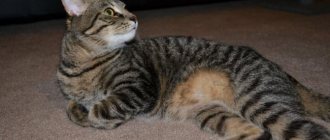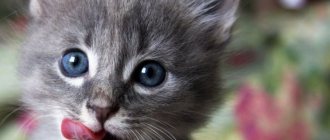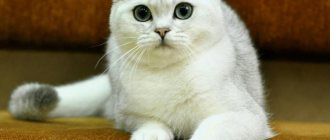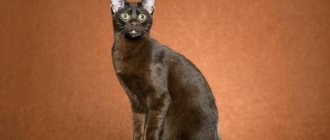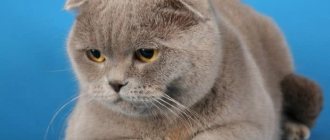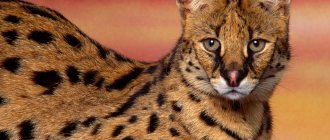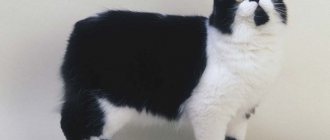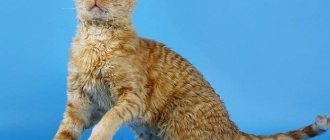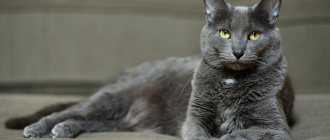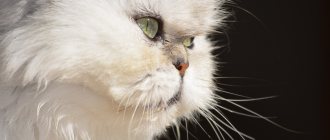History of origin
The breed is very young and continues to develop, but despite this it has already managed to win the recognition of many cat lovers. Toygers are recognizable and colorful pets; they are an entirely American breed.
In the late eighties of the twentieth century, breeder from Los Angeles Judy Sugden decided to breed a new interesting species of domestic cats. According to her idea, these pets were supposed to look like wild tigers. To achieve a similar effect, Judy decided to cross representatives of the Bengal and domestic tabby cats.
The breeder has been involved in breeding cats since childhood. Her mother is Jean Mill, a genetic biologist by training, and it was she who developed the Bengal breed. The daughter continued her mother's work and also became the founder of another new breed of domestic cats.
The main participants in the invention of the new breed were the Bengal cat with the complex name Millwood Rumple Spotskin and the simple domestic cat Scrapmetal. During her work, Judy selected various cats with interesting spotted coat patterns to reinforce the desired phenotype. The dominant Bengal cats were infused with the traits of a variety of short-haired breeds and mixed breeds with outstanding characteristic colors.
One day, Judy Sugden discovered a remarkable cat on the streets of Kashmir and brought him to her cattery, naming him Jamma Blue. This cat had spots and stripes on its face and ears, rare for pets. He became an important participant in the breeding work of the young breeder.
Nibelung cat breed, character and description
Since 1993, official registration of the breed by international felinological associations began, and by 2000, the TICA Toyger was included in the list of new cat breeds. In 2007, these cats were recognized as eligible for the championship. However, some felinological organizations have not yet registered this breed in their lists. In 2021, the Governing Council of Cat Fanciers evaluated Toygers and awarded them provisional status, which made these pets even more in demand.
This is beauty
Breed characteristics
Representatives of the breed are sociable and trusting cats. They are very inquisitive, but at the same time balanced and quite modest.
The toyger will always be happy to receive the attention of the owner, but if the owner is busy or simply not in the mood, the pet will not bother, but will find something else to do or calmly wait until the loved one is free.
These cats love company and meeting new people. They get along well with children and get along well with other cats and dogs. These pets are active and love to play with various toys. If there is a dog nearby, he will happily play with it and dog toys. At the same time, they also love a quiet pastime - sitting comfortably on the owner’s lap and spending the evening in a light nap.
Toygers are devoid of cowardice, so they are often the first to approach new people in the house and boldly explore new places. Since these cats are athletic and agile, they jump a lot and constantly climb into unusual places, especially at a young age when they are exploring their surroundings. Therefore, you need to carefully monitor your pet. However, Toygers, due to their high level of intelligence, are well trained and easily learn the rules and routines of the house.
These cats love to walk outdoors and quickly get used to a harness and leash.
Toygers are not arrogant, they quickly forget insults and troubles, and never take revenge. These are gentle cats, but not at all boring; their good nature should not be mistaken for weakness.
Egyptian Mau are leopard-colored cats from Ancient Egypt!
The history of the breed begins in Ancient Egypt, where these cats were considered sacred. Egyptian Mau are short-haired cats with elegant body shapes, large eyes and longer front hind legs. There are four officially registered subspecies of the Egyptian Mau, which differ in coat color and markings. Thus, they distinguish: smoky coat color and black spots, silver coat color with charcoal-colored spots, honey color coat with dark spots, pale yellow coat color with dark gray or brown spots. These are very reminiscent of leopards.
Big photo "
The character of the Egyptian Mau certainly does not resemble tigers or leopards. On the contrary, they are affectionate, playful and loyal. Also, these cats simply love to climb trees or other high places, and therefore it is very good if there are such cats nearby. A detailed description of the breed, character, and everything else about the Egyptian Mau can be found here.
Peculiarities
Representatives of the breed are very remarkable cats. Unlike the American Bobtail, but like the Mekong or Kuril Bobtail, they love water, so during bathing there are usually no problems; on the contrary, such a pet will happily accept water procedures.
Toygers are very emotional, but they are also extremely intelligent cats. They know how to make it clear what they need, but they will not constantly demand their way. These pets take grievances philosophically and never harbor anger. They are very easygoing, so they will not take revenge if they accidentally step on their tail or are not treated to a tasty morsel.
Representatives of the breed love communication and may even feel unwell if they are deprived of company for a long time. They don’t care whether it’s a person, a cat, a dog, Toygers will establish contact with everyone, quickly make friends and will happily give their affection.
Due to their sociability, Toygers make a variety of sounds. They can meow, purr and howl, but they do not do this often, plus the voice of these cats is quite quiet and not annoying. Problems with their talkativeness usually never arise.
Characteristics of Toyger cats
Once you take a Toyger kitten into your home, in a few days he will feel like a full owner. The pet quickly adapts to the new environment and easily finds a common language with members of the household. Moreover, the toyger cat does not just show his love from time to time, caressing and purring gently.
The cat will always be nearby, but at the same time his affection will never cross the line of decency and will not become intrusive. This pet has a pleasant voice. Toygers are not talkative, but communicate with their owners, not only using cat “meow” and “purr”, but making other unusual sounds.
In general, the tabby kitten “inherited” restraint and moderation in everything from its wild “relative”. They are active and playful, but are not averse to lying on their owner’s lap or taking part in joint entertainment. Another unusual feature of Toygers is their love of water. Experts are inclined to believe that purebred representatives of the cat world inherited this passion from their Bengal ancestors.
The Toyger cat is an absolutely non-conflict, non-aggressive animal. She gets along easily with other pets and never strives to take a leadership position. Cats simply adore children and are ready to play with them around the clock, taking breaks for food and rest. When interacting with children, Toyger cats will never bite or scratch them.
Toyger cats are smart and intelligent. It is easy to accustom them to a tray, scratching post and other useful devices. If desired, the owner can exercise with his pet and teach him tricks. In addition, it is worth considering that all cats of the described breed are terribly curious. They will strive to explore the contents of every drawer in the house, although they can be controlled - cats understand the word “no”.
Appearance
These cats are the embodiment of power and grace. Toygers are quite large pets, they have expressive facial features - a large chin, bright, attentive eyes, neat ears. Representatives of the breed have a peculiar physique. The body of these cats is somewhat elongated, the limbs are strong and slightly short, in general the cat gives the impression of a strong and agile pet.
The main feature of these cats is their specific striped color. Dark, clear stripes stand out well against a light background and form a beautiful pattern, which makes these cats look like little tigers. This color is called tabby mockerel, but Toygers have their own version of this coat pattern. The stripes are located on the torso and limbs, as well as on the head. Neat elongated spots are acceptable.
The name of the Toyger breed comes from two English words “toy”, which means “toy” and “tiger” - from English “tiger”.
These cats are shorthaired. Their hairs are soft, silky, with a very beautiful silver tint. The vibrissae (sensitive hairs) are quite long and thick, and the anus are dense, which gives them a somewhat menacing appearance of a predator. Despite their exotic wild appearance, Toyger cats are gentle, friendly, and this is easy to read in their facial expressions.
Breed standard
Miniature domestic tigers have the following essential traits:
At the exhibition
Head
- large, elongated muzzle;
- the back of the head is massive, the ears are neat, wide at the base, tapering and rounded at the tips, set wide apart;
- There must be stripes on the outside of the ear;
- the forehead is straight, there is a smooth transition to the bridge of the nose;
- eyes of medium size, set wide at an angle to the nose, yellow-green in color;
- the look is attentive and expressive;
- the nose is straight, the bridge of the nose is slightly rounded, widening towards the tip and becomes slightly flattened, quite elongated;
- the lobe is large, smooth, dark in color;
- The chin is strong, wide, and does not protrude forward.
Neck
- medium length, strong, flexible.
Torso
- quite large, noticeably elongated, strong, but not heavy;
- the shoulder girdle is wide and strong, which gives the front part of the body noticeable power, while the back part of the body is lighter;
- overall there are no signs of refinement.
Forelegs
- strong, medium length, quite thick due to well-developed muscles, but not loose;
- the paws are large, the toes are gathered into a ball, flexible;
- The pads are dark, almost black.
Hind limbs
- muscular, like the front ones a little short, but proportional;
- because of this, there is a feeling of a creeping springy gait;
- The paws are large, the toes are long, gathered into a round ball.
Tail
- sufficiently long, strong, rounded;
- the tip is dark, mostly black;
- movements add grace to the cat's image
Wool
- short, very thick and soft, at the same time quite elastic, has a silvery sheen;
- pleasant to the touch, smooth;
- on the stomach it is longer and thinner, also the hair is longer on the ears and cheeks, in place of the stripes, such a relief gives the color expressiveness.
Color
- modified tabby mackerel (striped) - representatives of the breed have clearer and more contrasting stripes on a light background, extended across the body;
- stripes ring the limbs, which corresponds to the color of tigers.
Dimensions
- these are medium or large pets, sexual dimorphism is pronounced (differences between females and males);
- cats weigh from 3 to 5 kg, males can weigh from 4 to 9 kg.
Disadvantages: slight deviations from the norm - size, somewhat disproportionate to the body, lack of stripes on some parts of the body (chest, head), ticking (presence of dark and light areas on the hair), light paw pads, tip of the tail, inappropriate eye color.
And here you will find the schedule of WCF cat shows for 2021.
Description of the Toyger breed
A tabby cat should look like a tiger. The main distinguishing feature of the breed is its stripes. They can be ringed or broken. But there should be stripes even on the stomach and paws. In addition to color, this cat must have a lot of muscle. In general, the cat should look like a tiger in appearance. Otherwise, why bother getting a toyger at all? There are TICA and WCF standards; breeders or simply lovers of tiger cats must follow these specific descriptions.
Toygers have a unique appearance
And I saw a toyger alive at an exhibition (October 3-4). I first recognized the owner from the photo, and then I went to look for the toyger. Well, I’ll tell you the beast, and what impressed me was not the size, or even the color, but the fact that it was a solid lump of muscles, i.e. it was a BEAST.
Aganava, forum user
https://forum.cats-paradise.ru/viewtopic.php?t=174&start=170
Appearance of a cat
Cats and tabby cats are considered quite large (females - up to 5 kg, males - up to 7.5–8 kg). According to the standard, the toyger has a long, wide head. The muzzle is shaped like an inverted heart (from the forehead to the whisker pads). Side view of the head - half a hexagon (points: chin, nose, forehead, back of the head). The ears of a tiger pet are rounded and small. There is thick fur on the temples and ears.
A beautiful feature of Toygers is their eyes of a rich, bright color. They cannot be big, but they are always round. The upper eyelid is slightly drooping. The cat's nose is long, but rounded and slightly flared towards the tip. By the way, the cat’s nose is also not lacking in muscles.
Toygers have large, expressive eyes
The body of the striped animal is long, muscular, and athletic. The chest is wide, but the shape is round. The paws are strong, especially the front ones, and the toes are long. The toyger's tail is long and muscular. The tip of the tail is rounded (lowered). The tabby cat's fur is short. Typically, the stripes can be fluffier, which makes the design look more embossed. And also longer hair on the temples and cheeks (it gives off shine). The stripes can be black or brown (or both). A prerequisite is strong color contrast. The striped fibers are colored from root to tip. The stripes do not have to be even; they can be full or slightly rounded.
The toyger cub's undercoat is mousy (light, gray, ashy) in color. The paw pads and the very tip of the tail must be black. There are circular stripes on the face. The cat looks like he's wearing light glasses. This impression is created due to the lightened fur around the eyes.
Photo gallery: Toyger's appearance from different angles
The toyger has a long, straight nose with a dark border just above the tip
The toyger's paws should also be striped
The toyger's chest should be striped or spotted
The toyger has small, neat ears, with a rounded edge
The toyger's tail is always striped, the tip of the tail is black
Character of a tabby cat
People who have not delved into the history of the origin of the breed may decide that since the cat’s appearance is tiger, then its character is animalistic and aggressive. This is not the case with the Toyger. This is a friendly, tame treasure. Such animals cannot be jealous of the owner of other animals, so they get along with other pets (except rodents, of course). Neighborhood with another cat or dog is even useful, because this way the cat will not be bored. A cat will feel bad alone; he knows how to miss his human.
The tiger pet gets along well with children. He will never offend a child, and will even play with him. If someone else is being petted in front of the toyger, he will not envy and beg to be petted. Such cats do not show aggression towards anyone (with the exception of moments of obvious danger). In general, tiger cats are very good-natured and peaceful. But this does not mean that they can be offended with impunity. Tiger seals have excellent muscles, and if attacked, they can fight back. We must not forget that cats are natural predators.
Toyger cats love to quietly watch family members
Despite their outward indifference, these cats are not at all opposed to affection from their owner. Therefore, in order for an animal to be happy, it needs to be given attention. The pet will not remain in debt - toygers are very loyal. These animals are also very active and love to play. And if a loved one pets his pet, the cat can sit like that for hours. Another character trait of the toyger is developed intelligence. These cats are extremely inquisitive, they need to know everything. They can remember the habits and behavior of the owner, and if necessary, use this to their advantage (they can even cheat and deceive a person). If your pet is distracted from lying comfortably in a chair, he will try to take part in the home event that caused him to be woken up. An unusual addiction of toygers is that they love to lick the hands of their person (as well as the hands of other family members). Therefore, if there are children in the house, then they need to explain the need for frequent hand washing.
My cat also likes to lick my hands. And not only hands, but also nose and ears. She especially likes to do this in the morning. Nobody knows why this happens, but it definitely has nothing to do with toygers. Perhaps this is a way of showing love and care. After all, cats lick their kittens not only when they are dirty. I take this as a sign of high intelligence.
Disqualifying faults
- various deformities;
- cryptorchidism (absence of one or both testicles in mature males);
- color inappropriate for the breed;
- polydactyly (more fingers than normal) and oligodactyly (fewer fingers);
- strabismus;
- pincer bite, undershot or overshot (normally – scissor bite).
In addition to external indicators, Toygers must have a stable psyche; these cats should not show aggression or cowardice.
Interesting photo
Calm grace
Yes, it's a tiger, just a small one
After games you need to rest
Before the jump
Handsome Toyger on a green background
Health and life expectancy
These are strong and healthy cats, as during competent selection they were inoculated with a variety of fresh blood. There are no specific genetic diseases observed in Toygers, but the most common problems can be considered HCM (hypertrophic cardiomyopathy - a disease characterized by thickening of the wall of the left ventricle of the heart, less often the right), some diseases of the digestive system (gastritis, colitis, pancreatitis), as well as obesity.
There is a strong opinion that representatives of the breed are poorly oriented in the area, so you should not tempt fate and let Toyger walk unattended. The best option is walking on a harness.
Diseases often occur due to errors in care, feeding, and only sometimes due to congenital pathologies. If you provide your pet with good living conditions, the Toyger usually lives on average 14 – 17 years, which is a good indicator.
Differences
These cats have characteristic, recognizable features with only slight variations. For example, markings on the coat can be either chestnut or black. A mixed color is also acceptable, but the main background is always red in different shades.
The main differences between cats and cats of this breed are their size. Females are medium-sized cats, while males are quite large cats. They have a more pronounced chin, a larger forehead, and denser ears. Also the paws are more muscular and powerful.
As for behavior, cats and Toyger cats are affectionate and inquisitive pets. Females can demonstrate independence to a greater extent, but at the same time they are softer and more gentle. Males, on the other hand, try more to be the center of attention and show sociability. Regardless of gender, representatives of the breed are excellent trainees and are cultured and well-mannered pets.
Be sure to install a scratching post for your cat
Purchasing a kitten
There is currently a toyger nursery in Russia. A small number of nurseries are engaged in breeding mini-tigers. There are no more than three or four of them throughout the country.
How much an animal costs depends on the purpose of its acquisition. Toyger kittens are quite expensive, about 1-2 thousand dollars. The price increases to 4 thousand dollars if the kitten is purchased for breeding, exhibitions and participation in competitions.
True toygers are kittens whose parents do not have other breeds in their pedigree. The author of the breed himself introduced a ban on crossing cats of this breed with others. This is explained by the desire to achieve maximum similarity with tigers.
Care
These cats do not require any special grooming. All manipulations boil down to standard hygiene maintenance. It is imperative to provide a safe interior, where there will be enough space for active games and constant warm-ups of the Toyger.
The fur of these cats is short and soft, and shedding is extremely sluggish and rare, so there is no problem with an apartment littered with hair. However, the Toyger needs to be brushed periodically with a soft brush. This allows you to renew the hair, add shine to the fur, and also bring pleasure to your pet with a pleasant massage.
You should not bathe your pet unnecessarily. Excessive water procedures, especially with the use of cosmetics, dry the skin, causing dandruff, itching and various other irritations. But you can bathe your pet 2–3 times a year. Toygers love water and usually enjoy bathing; they often perceive this procedure as fun and play in the water.
Be sure to brush your small pet tiger's teeth regularly. Every week, plaque is carefully removed from teeth at least 2–3 times. To do this, use special small brushes or wrap a thick layer of gauze on your finger, which you use to clean your teeth from all sides.
If necessary, Toygers have their claws trimmed. This manipulation is not difficult, but it requires certain skills and the presence of a high-quality tool - a nail clipper. You can trim your pet’s nails yourself or go to a veterinary clinic or groomer. Claws are trimmed as they grow, for some a couple of times a month is enough, for others – weekly. If a cat walks outside, trimming its claws is not recommended.
Since Toygers are active cats, they need a scratching post. You can choose a small special board or a massive game complex with a scratching post - these smart pets will quickly understand what the fun is for and will not spoil the furniture while caring for their claws.
It is useful to check the condition of the cat’s mouth, eyes, and ears every day. Carefully look into the mouth and assess the condition of the gums, palate, tongue and teeth. The eyes are wiped with a soft, lint-free cloth moistened with a special lotion or at least clean water.
On the contrary, you should not clean your ears often - no more than 2-4 times a month if dirt is noticeable. For this purpose, special oils and sprays are used, which are instilled into the ear canals. Such products soften wax deposits and other contaminants, and the unpleasant sensation from moisture getting into the ears forces the cat to shake itself off, which is why the dirt flies out on its own. The ears are wiped with a cotton pad or clean gauze, also soaked in a hygiene product. It is imperative that your pet regularly undergo a routine medical examination by a veterinarian and receive all treatments for external and internal parasites on time.
Breeds of cats with brindle color
In almost every yard there is a cat or she-cat with a brindle color. Therefore, for many, this color is associated with purebredness. However, in the world everything is completely different and a tiger cat in the house is a sign of wealth, since tabby cats are very popular.
Toyger
Outwardly similar to a tiger. The toyger is a large animal with a muscular build, wide bones, and high shoulders. The head is long, medium in size with small rounded ears. The eyes are brightly colored and round. The upper eyelid is slightly drooping. The nose is long.
According to the standard, a characteristic feature of the toyger is maximum color contrast. Color contrasts are everywhere: between the back and belly, the surface of the ears outside and inside. Vertical, uneven, braided stripes that close in rings on the neck, belly, paws and tail decorate the animal’s fur.
Toygers are calm, flexible, friendly, and sociable. They are smart, easy to learn games and tricks. They love water and swimming. They communicate well with children and other inhabitants of the house.
Toygers are healthy animals. They get heart disease. Prone to obesity. To avoid it, cats are fed dry food twice. There must be natural feeding: chicken breasts, offal, etc. With good care they will live 15 years or more.
There is a nursery in Moscow where these animals are cared for; the cost of a kitten starts from 60 thousand rubles.
Oncilla
Its color and build resembles a jaguar. She has a bright spotted color. She is the size of a regular house cat. Oncilla is a wild animal with a crepuscular lifestyle. Loves to climb trees and swims well. The beast is cruel and aggressive. It's better not to keep him at home. An unusual pet is usually kept in an enclosure.
The character is obstinate, loves loneliness. Activity at night, jumping ability, hunting for small animals cause trouble for the owner.
It is better to feed the animal beef and live food with mineral and vitamin supplements. The animal is fed once a day.
The animal is purchased from a nursery abroad on order. Kitten price starts from $2000.
Bengal cat
Looks like a leopard. This is a large-sized cat with an elongated, muscular body. Their hind legs are longer than their front legs. Thick, silky coat with dense undercoat, patterned with stripes, spots or rosettes. Color ranges from light golden to chocolate brown. Important! The pads on the paws and the tip of the tail are black.
Bengal cats are sociable, playful with a peaceful, affectionate nature. They are attached to their owner and love to walk with him down the street on a leash. Bengals are mobile, active, friendly with children and household members. They like games at heights. Bengals love water and love to swim. There is no need to comb them out.
It is better to feed cats natural food: meat, poultry and dairy products. You can use ready-made premium brand food with all the necessary vitamins. Bengal cats have good health and live up to 15 years.
Kittens cost 35-40 thousand rubles. In Russia there are nurseries in large cities where you can pick up a cheerful, active kitten who is easy to get along with.
Tabby
The color of cats is striped or spotted, similar to a tiger. Animals are calm, affectionate, energetic, and inquisitive.
Tabby cat
Tabbies are homebodies, love solitude, and relax in a secluded corner. They don't need anyone's company. Important! Suitable for single, busy people. They are tolerant of people and domestic inhabitants. Feed 3-4 times a day in small portions, preferably natural products.
There are only two nurseries with this breed in Russia. The price of a kitten ranges from 20 to 70 thousand rubles.
Sokoke
A breed of cat that originated from Kenyan forest cats. Animals of medium size with short hair, muscular, athletic. The color is brown in different shades. Active, love to climb, playful. They keep themselves busy with the game. They do not tolerate low temperatures. It's better to keep them at home. They get along well with children and other animals.
Animals are fed balanced feed with vitamin E and taurine to strengthen the cardiovascular system and improve metabolism. There is only one nursery in Moscow dedicated to this breed. A kitten costs from 30 to 100 thousand rubles.
Savannah
It resembles a cheetah in its color and grace. The famous cheetah spots of different sizes are scattered randomly throughout the fur and body. The color of the spots is brown or black, and the coat is chocolate, golden, brown, silver. The character is active, intelligent, and easy to train. If a Savannah kitten is initially affectionate, sweet and good-natured, then by the age of 3 he can turn into a wild animal. Therefore, it is recommended to keep the pussy in a special enclosure or in the courtyard of a private house.
Caring for them has its own characteristics. Savannahs do not like the cold, they love to jump, swim in the pool or in the nearest body of water. Long walks are recommended for pussies. An adult cat is almost half a meter tall and weighs up to 14 kg.
The animal must be fed meat and offal. Dairy products and foods high in grains should not be given. Can be fed with premium dry food. There is only one nursery with this breed, it is not in Russia. Kittens can cost from 500 thousand to 1.5 million rubles.
Egyptian Mau
The body is medium in size with well-developed muscles, the hind legs are slightly longer than the front legs. The coat is shiny, dense, silky. A distinctive feature is the contrast between the bright, spotted coat color and the dark spots on it and on the skin. Colors are smoky, bronze and silver.
Mau is an energetic, curious and playful cat. Buy lots of toys for them. She has strong hunting instincts and loves to track and catch prey. They get along well with children, dogs and other animals. Mau are loyal and devoted to their master.
Cats have diseases - allergies, cardiomyopathy, asthma. Animal allergens. Cats should be fed dry or canned food specially designed for this breed due to their tendency to allergies.
The price in Russia for a kitten reaches 100 thousand rubles. There is only one Moscow nursery https://egyptsila.ru/ that deals with this breed.
Asherah
A large, luxurious animal with an elongated, thin body, slightly disproportionate.
- royal golden-orange color;
- hypoallergenic with minimal protein concentration;
- snowy;
- ordinary, similar to a leopard.
The exotic beauty is considered a non-allergenic breed. These are affectionate and gentle cats with a balanced character, very sociable. They get along with children, with neighbors, with all household inhabitants. The mustachioed beauty loves active games and walks with her owner in the fresh air. Cats don't shed and you don't need to brush them.
Ashera cat breed
The exotic beauty is considered a non-allergenic breed. These are affectionate and gentle cats with a balanced character, very sociable. They get along with children, with neighbors, with all household inhabitants. The mustachioed beauty loves active games and walks with her owner in the fresh air. Cats don't shed and you don't need to brush them.
Ashers are recommended to eat natural foods in the form of fresh beef, poultry, sea fish, and so on. Dry food can be given to them as a supplement.
In Russia the price is 1.5 million rubles, they sell it with a veterinary certificate, all vaccinations have been completed. The Ashera is a rare animal, with only 100 kittens born per year.
You cannot find such a kitten in Russia; you need to look for it abroad, for example in the luxury-cats.com nursery.
Only true animal lovers, and quite wealthy ones at that, can have such cats and keep them in their home. The kitten grows into a large animal that needs to be well and properly fed with natural products or expensive dry food. Exotic cats will delight their owners with their beauty and playfulness.
Feeding
Toygers are active cats, so they need a diet rich in proteins, fats and carbohydrates. However, the digestion of these pets is quite sensitive. Some types of proteins may not be suitable for a domestic tiger, causing allergic reactions. For this reason, the diet for Toyger needs to be carefully prepared.
If you adopted a one-month-old kitten, you will need to feed it six times a day according to a special menu. You can read more details here.
It is important to find out what the breeders from whom the new pet was purchased fed the kitten and its parents. If the diet is correct and suitable for the pet, there is no need to change it. However, if necessary, switch to a different diet should be done gradually.
There are two options for feeding Toyger. The first is to choose ready-made branded food (dry, canned). In this case, no additional ingredients are required; it is only important to choose high quality food - at least premium - and monitor its calorie content. Since Toygers are prone to excess weight, they often choose low-calorie foods that are made specifically to help fight fat deposits.
When feeding natural products, you must follow the following rules:
- products must be fresh;
- Do not give sweets, baked goods, fried foods;
- It is important to enrich the diet with vitamins by periodically introducing vitamin-mineral complexes into food.
Regardless of the diet, the cat must have fresh, clean water freely available.
The Toyger's diet should include:
- meat (veal, rabbit, turkey, lamb, with caution - chicken);
- offal;
- sea or ocean fish without bones;
- fermented milk products (low-fat cottage cheese, kefir, hard cheese, fermented baked milk);
- cereals (rice, oatmeal, buckwheat);
- vegetables and fruits (pumpkin, carrots, apples, cucumbers).
You can add a boiled egg 1 – 2 times a week. Vegetables are given to Toygers quite often, as the high fiber content helps control weight. Fish is given in moderation. Meat and seafood must be subjected to heat treatment - fed only boiled.
Please note that there are automatic feeders not only for dry food, but also for natural food. It will cool it and heat it up if necessary, and will issue it in time and notify you on your smartphone that everything is in order. In addition, it is recommended to purchase an automatic drinker as part of the kit. Then the cat will receive clean, filtered, oxygenated water.
Caring mother with kittens
Mating, pregnancy and childbirth
The breed continues to develop, so it is important to choose the right pair in order to consolidate the necessary traits and not harm the progress of the breed. Toygers are strong cats, they are able to bear healthy offspring and lamb on their own.
Despite early sexual maturity - already at six months of age the Toyger’s body is ready to produce offspring, these pets generally take quite a long time to mature. Only by the age of one and a half to two years can they be called “adults”. Therefore, the best time for mating is considered to be from the age of two years.
Before breeding, it is imperative for cats and females to undergo all necessary treatments against ecto- and endoparasites, and also make sure that all vaccinations have been completed. Pregnancy lasts 56–64 days, sometimes it can last a week longer. It is helpful to have veterinary checkups during this period.
Both during pregnancy and after giving birth, it is extremely important to follow all the rules of feeding the cat’s mother. This is the only way you can get healthy offspring from her.
At the end of the term, the cat gives birth to an average of two to six kittens. If everything goes well, there is no need to interfere with the process. You just need to stock up on a sufficient number of clean towels, rags, and also keep threads, scissors, and iodine with you. It would be a good idea to purchase a package of cat milk replacer in advance in case you have a large number of kittens.
But we should not exclude those rare cases when a woman in labor needs help. It is important to notify the attending veterinarian in advance so that he can quickly respond and help.
After the kittens are born, they need to be examined for developmental abnormalities (cleft palate, absence of anus, other more noticeable anomalies) and be sure to be allowed to be licked and fed by the mother. Next, there is no need to disturb the new family again; you just need to provide them with a cozy, warm place with free access.
Advantages and disadvantages
Although this is a very young breed, these cats have already become desired pets for many exotic lovers. Toygers have many advantages:
- high level of intelligence - Toygers are highly trained and accurately understand the owner;
- affectionate disposition - representatives of the breed are devoid of aggression, friendly to everyone and very gentle;
- unpretentious in care;
- very funny and playful - they become an interesting friend for adults and children;
- very clean;
- quite modest, will not impose themselves;
- unusual appearance - a strong resemblance to a wild tiger gives these cats a unique flavor.
Like everyone else, Toygers have some disadvantages:
- excessive curiosity and high activity - Toygers need to be constantly monitored and controlled;
- a tendency to climb into the most unexpected places and get lost - the exploratory nature of these cats often leads them to all sorts of hard-to-reach places, from where they are difficult to get;
- Toygers do not particularly single out their owner, so many representatives of the breed communicate equally confidentially with both the owner and strangers.
Such pets are perfect for both single people and large families, and get along well with other pets. However, they are not suitable for owners who do not have the opportunity to devote enough time to raising and communicating with their pet.
If you like this breed, you can visit the International Cat Show Spring 2021 in Perm.
Kitten Toyger
Meet the pet tiger
Long before the breed appeared, the famous writer Victor Hugo said that God gave man the opportunity to pet a tiger when he created the cat. But the beast’s character turned out to be... well, quite soft. This is good - there is no danger of being maimed, unless the kitten catches your hand with a claw during play.
The toyger is one of the youngest breeds and is not widespread, so the price of a toyger cat reaches 150-200 thousand rubles. Interestingly, all foreign breeders are required to make contributions from the sale of kittens to a fund to support tigers living in the wild.
This condition was set by Judy Sugden. She can be called the “mother” of all toygers. For a long time she nurtured the idea of breeding a domestic cat whose appearance would have the maximum resemblance to a wild predator.
Judy already had an example from her mother. Jen Mill developed a breed of Bengal cats.
How to choose a kitten
Having decided on the breed, it is important to choose a reputable breeder or professional nursery. You can often run into scammers selling outbred tabby kittens under the guise of Toygers.
After making inquiries about the cattery and making sure of the quality of care of the cats, you can choose a new four-legged friend. It is important to pay attention to the following points:
Place of detention
- kittens should live in a clean, warm environment;
- the tray is cleaned and washed, the special filler is clean;
- You may have to offer your pet several toilet models before he chooses the one that suits him best;
- absence of unpleasant, pungent odors.
Appearance
- the kitten must be proportional, well developed, size appropriate for its age;
- eyes, nose, ears – clean, mucous membranes – pink, moist, without damage;
- hair – without bald patches, shiny, clean;
- the area under the tail is clean, without irritation;
- the skin is elastic and undamaged.
Behavior
- kittens should be active, inquisitive, and not show cowardice;
- movements and poses are free and relaxed.
It is necessary to make inquiries about the kittens' parents: age, living conditions, feeding, what diseases they have, what kind of litter they have.
European shorthair cat
Differences from similar breeds
In addition to Toygers, there are some other breeds with “wild” colors. But these cats have a number of differences.
European shorthair cat
A very common breed of domestic cat, which arose naturally and developed independently. These cats differ from Toygers in many types of colors, in addition to tabby and its variations. The stripes are not so pronounced, the pattern can be different. Also, the physique of representatives of this breed is more delicate.
Bengal cat
Bengal
The Bengal cat is the direct ancestor of the Toyger, so it is not surprising that there are noticeable similarities. However, Bengals, unlike Toygers, are spotted, not striped, cats.
Their coat has a similar shiny sheen, but the pattern of spots and stripes is different. Bengals do not have markings on their ears and belly like Toygers. These cats are also more restive.
Soukok
Soukok
The original striped breed differs from the Toyger in the pattern on its coat - instead of parallel stripes, dark zones form spectacular rosettes on a light background.
In addition, they are allowed to have simply dark spots. Soukoks are more refined than Toygers, noticeably smaller in size and have a delicate constitution.
Ocicat
Ocicat
This is a similar breed to the Toyger, but has certain differences. The coat tone is very similar, but the Ocicat has a different pattern - spots that form a certain pattern or geometric shapes.
Representatives of the breed are somewhat smaller than Toygers and have thinner and longer limbs. Their gait is more graceful and their appearance more sophisticated.
The most famous brindle cat breeds
Toyger is a real domestic tiger.
An elite breed of cats, not accessible to everyone, but fascinating in its resemblance to its wild and majestic ancestor. Only a specialist can distinguish the American Shorthair from the ordinary Russian Boris. A very active and strong cat who loves to jump and chase toys.
The short-legged munchkin can also be striped. The breed is rare and highly prized.
Siberian cat. Our dear, chic person with thick velvety fur. It was especially popular at a time when it was extremely difficult to find a hybrid breed. Now it is no longer so attractive to be purchased by our compatriots, but still often encountered and loved.
The Maine Coon is a larger version of the Siberian cat with tufted ears and impressive size.
Interestingly, striped animals, unlike many, can actually speak with their eyes. All their emotions and feelings are instantly imprinted in the expression of their muzzle, and it is quite difficult to distinguish one emotion from another - they are caricatures.
Price
Since the breed is new and not yet widespread, most often such pets are imported from other countries, mainly from the USA. These cats are expensive, their price varies depending on the class. Representatives of the pet class without documents can cost $300–500 (20,000–30,000 rubles), cats that have a pedigree and a package of necessary papers cost at least $600–800 (40,000–50,000 rubles).
New Ragamuffin cat breed
Breeding class kittens can be bought for no less than $1,200 (from 80,000 rubles), and the price of show class representatives, potential champions, starts from $1,500 – 1,600 and higher (from 95,000 – 100,000 rubles).
Savannah is a leopard breed of “domestic serval”!
Work on breeding a cat breed that would be large in size, spotted in color and have a characteristic ear shape began back in the 80s of the last century. After a decade of attempts, breeders managed to create domestic cats similar to servals. For this purpose, an African serval was crossed with a domestic cat. Leopard-printed breeds (Bengal, Egyptian Mau), like the Serval, were used as domestic cats. As a result, a smaller copy of the serval was obtained - Savannah.
Big photo "
Nevertheless, representatives of the Savannah breed are the largest cats in the world (among domestic cats, of course) and can reach 60 cm in height. But in character this breed is not at all wild; on the contrary, it is very calm. Although these cats simply adore active games, as well as walks outside. Apart from everything else, Savannah is one of the most expensive cat breeds.
This concludes our list of cat breeds with brindle and leopard colors. Of course, many domestic breeds can also have stripes or spots on their base coat color. However, they come in a wide variety of colors, and today we were talking about breeds that are exclusively brindle or leopard in color . In conclusion, we suggest watching a video about cute miniature tigers - Toygers.
Interesting Facts
- The name of the breed is derived from the English words “toy” and “tiger”, which literally means “toy tiger”.
- The intelligence of these cats is much above average, so Toygers learn quickly and easily, are happy to perform some interesting tricks, and also get used to something new.
- Despite their appearance and wayward ancestors, Toygers are very affectionate and balanced cats. They are modest, peaceful and gentle with children.
- These cats are not afraid of water. On the contrary, many Toygers love to splash around in the bathtub, playing with the babbling stream.
- Toygers do not have the same pronounced hunting instinct as, for example, Bengals or Abyssinians. However, it is still worthwhile to exercise reasonable caution and carefully monitor if a representative of the breed communicates with a potential victim - rodents, birds.
- These pets lose hair rarely and in small quantities, so it is easy to keep their home clean. And although Toygers are not considered hypoallergenic cats, this is suitable for people suffering from allergies.
How to raise a pet tiger cub
Toyger kittens are born extremely smart. They are unusually attached to their owner and have a hard time withstanding separation. Little “tiger cubs” are playful and frisky; they play with children with pleasure, without trying to let out their claws.
High intelligence contributes to the rapid learning of the kitten. Toygers have no problems learning to use a tray or scratching post. Kittens are not afraid of water; they enjoy playing with streams of water and swimming.
Caring for the fur is simple - you don’t need to wash it with shampoo often, but you can let your cat frolic in the bath regularly.
Cats do not have any special health problems. True, like true tigers, they are fearless and often forget to be careful, so you should not keep the windows open in an apartment located on a high floor if a toyger lives in it.
It is important to provide your cat with a healthy, balanced diet, since even with high activity, Toygers are prone to obesity.
Note!
Singapore cat: character, photo, price, breed description, reviews, how to buy, how to choose, maintenance, care and owner reviews
Scottish Straight: cat photo, kitten prices, breed description, character, reviews, maintenance and care, nutrition + interesting facts
Chausie - overview of the breed, character and breeding characteristics. Price for a kitten and tips for choosing a purebred cat (115 photos)
Toygers love to meow. And they do it when they want. The range of their voice is wide: from high melodic trills to loud insistent meows. The cat doesn’t need anything - he just got bored.
Therefore, before asking how much a toyger costs and where to buy one, get ready to be woken up in the middle of the night by the loud voice of a striped pet.
